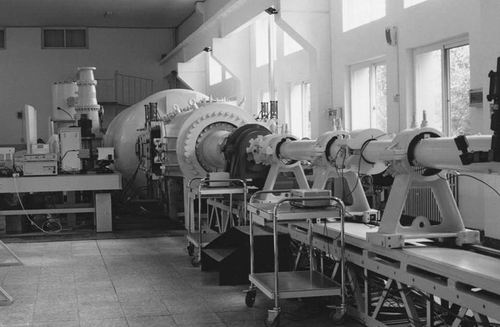
Yu Hongru receives the award on the stage.
Yu Hongru, a gasdynamicist, was born in June 1928 in Guangfeng County, east China's Jiangxi Province. He was elected a member (an academician) of the Chinese Academy of Sciences (CAS) in 1991. On April 8, 2024, he was honored with the award of Person Touching China for 2023.
He is one of the forerunners in the research and application of shock tubes and shock tube wind tunnels in China, and is hailed as the "Pioneer of shock tube wind tunnels in China". He has devoted more than 60 years to wind tunnel research, and led the design of multiple wind tunnel models throughout his life, making significant contributions to the development of China's aerospace industry.
Developing wind tunnels to boost the aerospace industry
In early 1956, the Central Committee of the Communist Party of China called for "advancing into science". Yu Hongru applied for the postgraduate program at the Institute of Mechanics, Chinese Academy of Sciences, and became a student of Guo Yonghuai, a renowned scientist of Mechanics and Applied Mathematics.
In early 1958, the Shock Tube Group was established at the Institute of Mechanics, and Guo Yonghuai appointed Yu Hongru as the group leader. At that time, China had a weak economy and was short of electricity supply. Such a situation made it impossible to follow the path of foreign countries to develop wind tunnels. Therefore, Yu Hongru chose the more economical method of using hydrogen-oxygen combustion as the driving force. However, this method was prone to explosions and was extremely dangerous.
Yu Hongru experienced several accidents during early shock tube experiments, and one serious incident even destroyed a temporarily built shed.
After many trials and analyses, Yu Hongru finally led the team in blazing a new path for wind tunnel research in China. In 1958, the core component of the shock tube wind tunnel, the first-generation shock tube in China, was successfully developed.
From December 1958 to the end of 1959, all members of the shock tube group were transferred to the 140 department (CAS' aerodynamics experiment department which undertook cutting-edge national defense tasks) to support wind tunnel construction and engage in the configuration and development of measuring instruments for supersonic wind tunnel. Yu Hongru served as the leader of the wind tunnel measurement group. In 1962, the straight-through wind tunnel JF-4 was established, and in 1964, the reflecting shock tube wind tunnel JF-4A was built. In 1969, China's first large-scale hypersonic wind tunnel, the JF-8 shock tube wind tunnel, was completed.
Pioneering spirit leads to the innovation of detonation drivers
In the early 1960s, when analyzing an accident in a shock tube hydrogen-oxygen combustion experiment, Yu Hongru discovered that the root cause was the occurrence of detonation. Detonation is extremely dangerous and should be avoided as much as possible. However, Yu Hongru took a different approach and elucidated the laws of detonation. From September to December in 1988, as a scientist of the Chinese Academy of Sciences nominated and invited by the Max Planck Society of West Germany, he participated in the special research on "hypersonic and high-enthalpy flow" at the Shock Wave Laboratory of RWTH Aachen University, completing fundamental experiments on the detonation drivers and successfully developing reverse detonation driving technology after returning to China. In 1998, Yu Hongru, along with Zhao Wei, Lin Jianmin, and others, completed the world's first detonation-driven shock tube wind tunnel, JF-10.

Hydrogen-oxygen detonation-driven high-enthalpy shock tube wind tunnel JF-10
In 2001, Yu Hongru and Chen Hong, among others, pioneered the dual detonation-driven propulsion method, overcoming the serious problem of strong shock wave attenuation caused by forward detonation driving. In 2012, the hypersonic flight-duplicated shock tunnel JF-12 made its debut at the Qian Xuesen Engineering Science Experiment Base in Huairou District, Beijing, leading the development of advanced wind tunnel technology internationally.
However, despite his numerous significant contributions, he remained extremely modest. When asked by an interviewer about his feelings of seeing the major national weapons in front of Tiananmen Square during a military parade, Yu Hongru said, "We just helped a little bit".
For decades, Yu Hongru has also trained and cultivated many postgraduate and doctoral students, who have become academic elites and pillars of the nation. Besides, he still serves as a part-time professor in such universities as the University of Science and Technology of China, the National University of Defense Technology. By actively cultivating talents and strongly supporting the development of mechanics disciplines in these institutions, he has made great contributions to the education of mechanics in Chinese universities.













